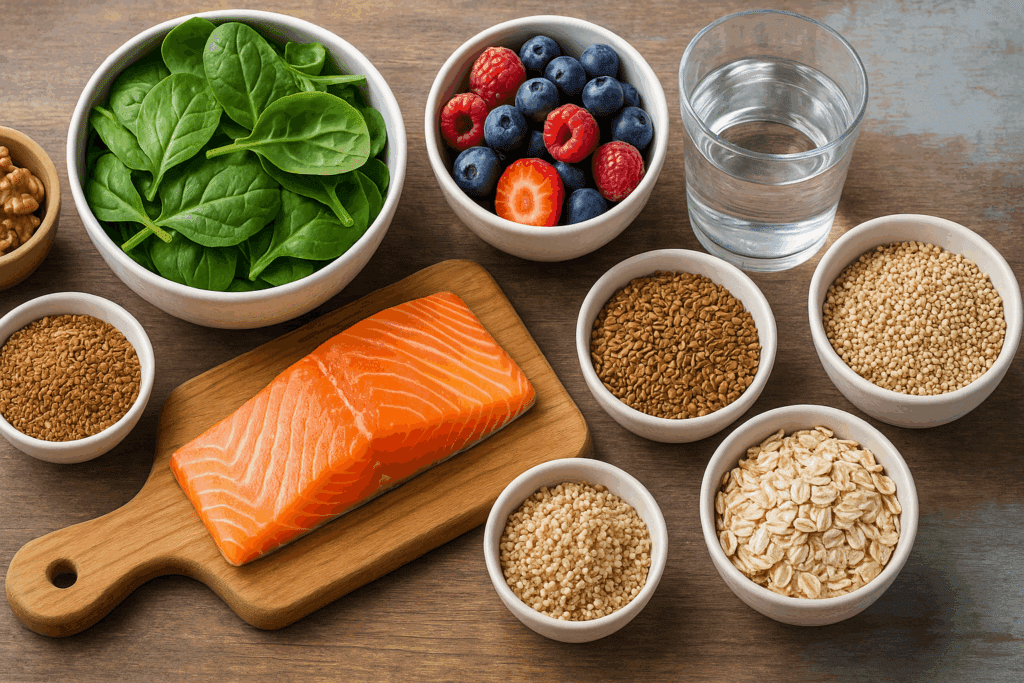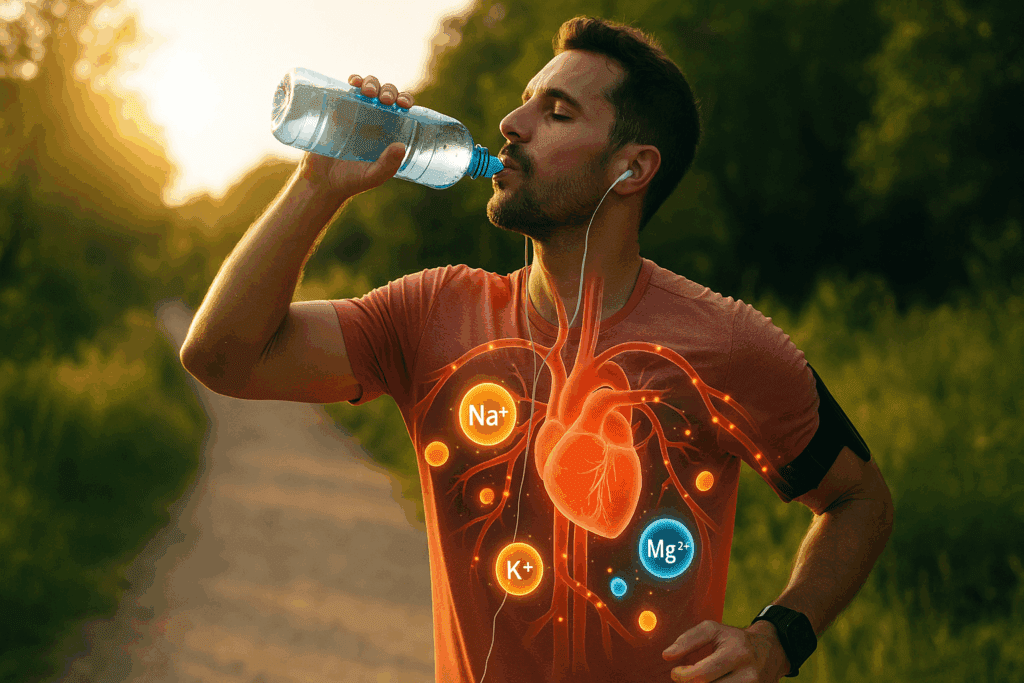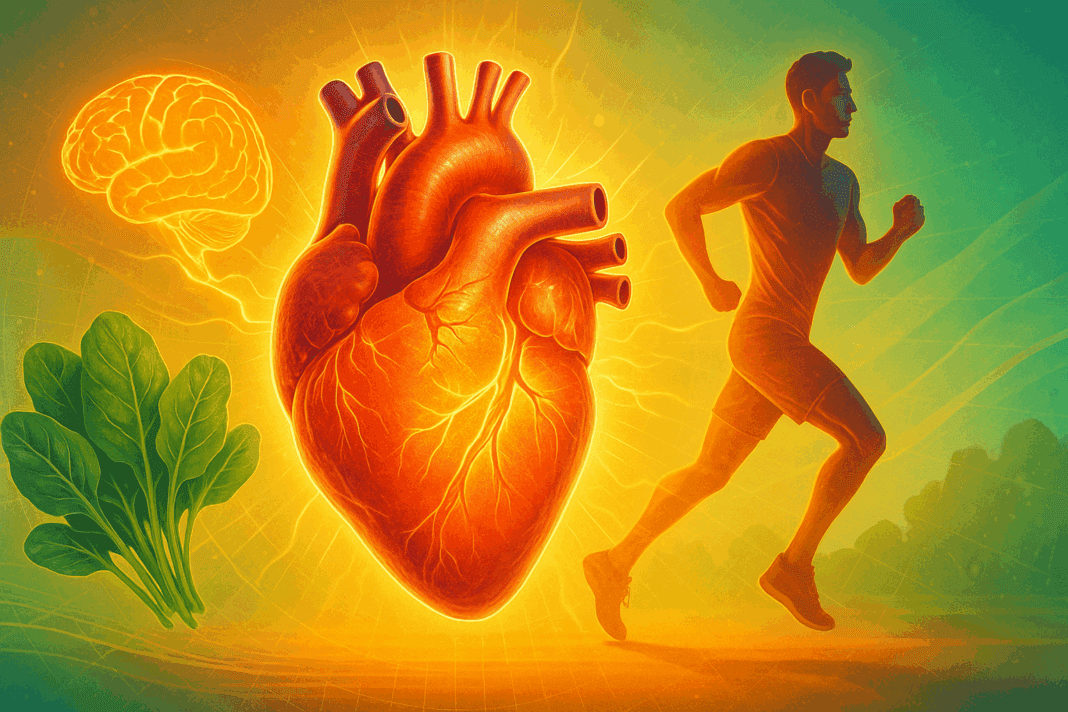The human heart is more than a vital organ pumping blood—it is the engine that sustains endurance, supports performance, and enables a thriving lifestyle. In a society increasingly focused on short-term fitness gains and high-performance hacks, genuine heart protection is often overlooked. Yet, true cardiovascular strength isn’t built overnight. It requires a natural, consistent, and science-informed approach that aligns with the body’s physiology and long-term health. By learning how to keep your heart protected naturally, you not only reduce the risk of heart disease but also enhance stamina, physical resilience, and energy output over time.
You may also like: Smart Nutrition Choices for a Healthier Lifestyle: What to Know About Whole Grain Rice and Whole Wheat Rice

Understanding the Foundations of Human Heart Protection
To protect the human heart effectively, it’s essential to understand its biological mechanics and vulnerabilities. The heart is a muscular organ, roughly the size of a fist, responsible for pumping oxygenated blood throughout the body. While it appears robust, its function can be compromised by poor diet, sedentary behavior, chronic stress, environmental toxins, and lack of quality sleep. Over time, these factors increase the risk of atherosclerosis, hypertension, and cardiomyopathy, which are leading contributors to cardiovascular disease. Human heart protection, therefore, starts with prevention and education, grounded in evidence-based strategies.
A key component of heart protection is metabolic health. Elevated blood glucose and insulin resistance significantly increase the heart’s workload and promote inflammation, which accelerates arterial plaque formation. Keeping your heart protected naturally begins with maintaining insulin sensitivity and metabolic flexibility. This can be achieved by regulating sugar intake, improving mitochondrial function through consistent aerobic exercise, and ensuring the body uses fat and carbohydrates efficiently for fuel. Understanding how these internal processes affect cardiovascular resilience empowers individuals to take control of their heart health from the inside out.

Nutrition as a Cornerstone of Cardiovascular Endurance
Diet is one of the most powerful and modifiable tools for maintaining a heart protected against chronic disease and age-related decline. Research consistently highlights that diets rich in whole, unprocessed foods contribute significantly to human heart protection. Specifically, incorporating omega-3 fatty acids from sources like wild-caught salmon, flaxseed, and walnuts has been shown to reduce inflammation and improve endothelial function. These effects enhance blood flow and reduce the strain on the heart during endurance activities.
In addition to omega-3s, a diet rich in antioxidants supports the body’s ability to neutralize free radicals, which otherwise cause oxidative damage to cardiovascular tissues. Berries, dark leafy greens, and cruciferous vegetables provide polyphenols and flavonoids that promote vasodilation and reduce oxidative stress. Whole grains, especially oats and quinoa, provide soluble fiber, which helps lower LDL cholesterol without affecting beneficial HDL cholesterol. This lipid-balancing effect is essential for keeping the heart protected over time, particularly in the context of a performance-driven lifestyle.
Sodium intake, often vilified, also deserves a nuanced discussion. While excess sodium can exacerbate hypertension in sensitive individuals, an excessively low sodium intake may impair performance and increase the risk of hyponatremia, especially among endurance athletes. Instead of an arbitrary restriction, sodium should be managed contextually, in tandem with potassium intake and hydration practices. Achieving the right balance ensures fluid regulation, nerve conduction, and muscle contractions occur optimally—all critical for peak cardiovascular performance.

Exercise for Endurance and Cardiovascular Strength
Physical activity is the most direct way to enhance cardiovascular endurance while also keeping the heart protected naturally. Consistent aerobic training such as brisk walking, cycling, swimming, or running strengthens the heart muscle, increases cardiac output, and improves VO2 max, which reflects the body’s ability to use oxygen efficiently. These adaptations not only support long-term health but also boost performance in both athletic and daily activities.
High-intensity interval training (HIIT) has emerged as a powerful modality for improving cardiovascular efficiency without requiring long hours of steady-state exercise. Studies show that HIIT protocols can lead to comparable or even superior improvements in heart rate variability, stroke volume, and mitochondrial density when compared to traditional endurance training. This makes HIIT a valuable tool for time-efficient human heart protection, especially for individuals balancing demanding schedules.
However, moderation and recovery remain essential. Overtraining without sufficient recovery may increase levels of cortisol and inflammatory cytokines, both of which can compromise heart health. Incorporating active recovery sessions, prioritizing rest days, and monitoring heart rate variability can help individuals strike the right balance. Keeping the heart protected isn’t just about pushing it to work harder; it’s also about knowing when to allow it to rest and rebuild.

The Role of Stress Management and Emotional Wellness
Chronic psychological stress has a profound effect on the cardiovascular system. It activates the sympathetic nervous system, leading to elevated cortisol levels, increased heart rate, and higher blood pressure. Over time, this can contribute to arterial damage and increase the risk of events such as heart attacks or arrhythmias. Learning to manage stress effectively is thus integral to maintaining a heart protected from these physiological insults.
Mindfulness-based practices like meditation, breathwork, and yoga have shown promise in reducing systemic stress markers and enhancing heart rate variability—a key indicator of cardiovascular adaptability. Regular practice not only improves mental clarity but also strengthens parasympathetic tone, which allows the heart to recover more quickly from periods of exertion or emotional arousal. In this way, emotional wellness becomes a powerful contributor to human heart protection.
Social connection and community involvement also play a significant role. Studies have found that individuals with strong support networks and a sense of belonging experience lower levels of stress hormones and reduced risk of cardiovascular disease. This highlights the importance of not only managing stress but also fostering meaningful human relationships as part of a holistic approach to endurance and performance.

Sleep and Recovery: The Underestimated Elements of Heart Protection
Quality sleep is one of the most underestimated factors in human heart protection. During deep sleep, the body undergoes critical repair processes, including cardiac muscle regeneration, hormone regulation, and nervous system recalibration. Individuals who experience chronic sleep deprivation face an increased risk of hypertension, arrhythmias, and metabolic syndrome—all of which undermine cardiovascular endurance and long-term heart protection.
Sleep apnea, often undiagnosed, is particularly harmful. This condition causes repeated interruptions in breathing throughout the night, leading to oxygen desaturation and spikes in blood pressure. Over time, it significantly raises the risk of heart failure and stroke. Individuals who snore loudly, feel excessively tired during the day, or wake up gasping for air should seek medical evaluation. Effective treatments, such as CPAP machines or lifestyle modifications, can dramatically reduce cardiovascular risk.
To keep the heart protected naturally through sleep, it’s essential to establish a consistent sleep schedule, reduce exposure to blue light in the evening, and prioritize a dark, cool sleeping environment. Sleep hygiene practices that support deep, restorative rest can lead to measurable improvements in blood pressure regulation, autonomic balance, and emotional resilience. These factors all contribute to a heart that is not only strong but also adaptable.

Hydration and Electrolyte Balance for Cardiovascular Efficiency
Water is fundamental to life, and nowhere is this more apparent than in the cardiovascular system. Proper hydration ensures that blood volume is maintained, allowing the heart to pump efficiently and oxygen to reach working muscles. Dehydration, even at mild levels, increases blood viscosity, forcing the heart to work harder to circulate blood. This added strain can compromise both endurance and cardiovascular safety.
Electrolytes such as sodium, potassium, magnesium, and calcium play a vital role in heart rhythm and muscular contraction. Imbalances—either through poor diet, excessive sweating, or overconsumption of diuretics—can lead to arrhythmias, cramps, or even cardiac arrest in extreme cases. Individuals engaging in prolonged endurance activities must be especially attentive to replenishing electrolytes, ideally through a combination of whole foods and targeted supplementation.
Magnesium, in particular, is essential for human heart protection. It supports vascular relaxation, reduces systemic inflammation, and helps maintain normal blood pressure levels. Despite its importance, magnesium deficiency is surprisingly common, especially in individuals who consume processed foods or experience high stress. Incorporating magnesium-rich foods such as pumpkin seeds, spinach, and legumes, or using magnesium glycinate supplements, can support cardiovascular resilience and improve performance outcomes.

The Importance of Functional Testing and Biomarker Tracking
One of the most effective ways to ensure your heart is protected over time is through proactive testing and monitoring. Functional diagnostics, such as lipid panels, inflammatory markers (like C-reactive protein), and VO2 max testing, offer insights into cardiovascular function and help guide individualized interventions. These tests go beyond routine screenings and allow for a more nuanced understanding of how lifestyle, diet, and training are affecting heart health.
Heart rate variability (HRV) has gained significant traction among performance-minded individuals seeking to optimize recovery and endurance. HRV reflects the balance between sympathetic and parasympathetic nervous system activity and is a dynamic marker of stress resilience. A higher HRV generally correlates with better cardiovascular health and adaptability. Tracking HRV over time can inform training intensity, stress management practices, and sleep quality adjustments.
Wearable technology has made this type of tracking more accessible. Devices like the Oura Ring, WHOOP band, and Garmin smartwatches provide real-time data on heart rate, sleep stages, and recovery trends. When used properly, these tools empower users to make informed decisions about their routines and behaviors, ultimately supporting their goal of keeping the heart protected through data-driven choices.
Supplements That Support a Naturally Protected Heart
While food should always be the foundation of heart health, certain supplements can offer additional support for those looking to optimize performance and maintain a heart protected from oxidative and inflammatory damage. Coenzyme Q10 (CoQ10), for example, is crucial for mitochondrial energy production and has been shown to improve endothelial function and reduce blood pressure. Its benefits are especially pronounced in individuals taking statins, which can deplete natural CoQ10 levels.
Another powerful supplement is L-citrulline, a precursor to nitric oxide. By improving vasodilation and blood flow, L-citrulline enhances oxygen delivery to muscles during endurance activities and supports post-exercise recovery. It is particularly useful for athletes and those engaged in high-intensity training looking to maximize cardiovascular efficiency.
Beetroot powder, rich in dietary nitrates, is another evidence-based supplement for cardiovascular endurance. Multiple studies demonstrate its ability to lower blood pressure and improve time-to-exhaustion during aerobic exercise. These benefits, combined with its natural anti-inflammatory effects, make beetroot a valuable addition to a holistic heart protection regimen.
Frequently Asked Questions (FAQ): How to Keep Your Heart Protected Naturally
1. Can mental focus and cognitive performance affect cardiovascular health over time? Yes, the brain and the heart are intricately connected through the autonomic nervous system, and cognitive strain can place long-term stress on cardiovascular function. Individuals with chronic mental fatigue or poor emotional regulation often experience elevated cortisol, which over time can harm endothelial health. Integrating mindfulness, productivity breaks, and digital detoxes can improve both cognitive clarity and cardiovascular resilience. In high-pressure professions, mental exhaustion can act as a silent barrier to keeping the heart protected. Supporting brain health through nootropics and natural adaptogens may have a beneficial ripple effect on human heart protection, especially when used alongside evidence-based cardiovascular strategies.
2. Are there emerging technologies that help optimize heart protection during endurance training? Absolutely. Wearable tech has evolved beyond basic heart rate monitors and now includes advanced features like continuous ECG monitoring, recovery analytics, and blood oxygen saturation tracking. These innovations offer real-time insight into cardiac strain, helping athletes keep their heart protected during both intense workouts and recovery phases. Smart fabrics that detect hydration levels and muscle oxygenation are also entering the market, allowing for more refined approaches to human heart protection. When used correctly, these tools bridge the gap between subjective perception and physiological reality, offering a more intelligent, data-driven path to endurance.
3. How can heat exposure, like saunas or hot yoga, influence cardiovascular strength and heart protection? Controlled heat exposure has been shown to positively impact vascular flexibility and reduce arterial stiffness. Practices like sauna therapy induce mild cardiovascular stress that mimics aerobic activity, promoting greater circulation and endothelial health. When done safely and consistently, these routines can help keep the heart protected naturally by enhancing heat shock protein activity and lowering systemic inflammation. For those unable to engage in traditional exercise due to injury or age, passive heat exposure offers an alternative route to human heart protection. It is, however, crucial to hydrate adequately and monitor blood pressure when integrating heat therapy.
4. What role does gut health play in long-term cardiovascular protection? Emerging science suggests that gut microbiota play a profound role in modulating inflammation, lipid metabolism, and even blood pressure. Specific strains of beneficial bacteria are linked to the production of short-chain fatty acids that protect arterial walls. Disruptions in gut flora from poor diet, antibiotics, or chronic stress can compromise efforts to keep the heart protected. A diet rich in fermented foods, fiber, and prebiotics can promote a microbiome conducive to human heart protection. Additionally, gut permeability (“leaky gut”) can allow inflammatory compounds into the bloodstream, directly affecting cardiac tissues over time.
5. Are there psychological factors beyond stress that affect cardiovascular resilience? Yes, psychological traits like optimism, resilience, and a sense of purpose have been linked to lower risks of heart disease. Studies show that individuals with a strong sense of meaning in life are more likely to adhere to healthy behaviors, indirectly helping keep the heart protected. Furthermore, emotional suppression and unresolved trauma can chronically activate the sympathetic nervous system, placing the cardiovascular system in a prolonged state of alert. Practices like expressive writing, therapy, or community engagement can indirectly support human heart protection by improving emotional and psychological regulation. Addressing the mind-heart connection is a vital component often overlooked in traditional cardiovascular strategies.
6. How do environmental toxins influence cardiovascular risk, and what can be done naturally to counteract them? Heavy metals, airborne pollutants, and endocrine disruptors are all known to interfere with vascular health and mitochondrial efficiency. These toxins contribute to oxidative stress, a key factor in arterial damage and plaque formation. To keep the heart protected in a modern environment, individuals can incorporate natural chelators like chlorella, cilantro, and pectin-based fibers to assist detoxification. Additionally, using HEPA filters indoors and reducing exposure to plastics and chemical-laden products supports long-term human heart protection. Antioxidant-rich foods and glutathione-boosting strategies (like consuming cruciferous vegetables) further fortify the body’s natural defense systems against environmental cardiovascular threats.
7. Can proper posture and spinal alignment impact heart protection and endurance? Though often underestimated, posture plays a vital role in respiratory efficiency and blood circulation. Poor alignment compresses major arteries and nerves, disrupting optimal oxygen delivery to the heart and peripheral tissues. Techniques such as Alexander Technique, chiropractic care, or functional movement training can reduce biomechanical strain, helping to keep the heart protected during physical activity. Especially during endurance training, spinal mobility and thoracic expansion directly influence cardiac output. For comprehensive human heart protection, integrating posture correction into one’s routine can optimize both form and function.
8. What are some less-discussed herbal or natural compounds that may support cardiovascular endurance? Beyond the well-known options like garlic or turmeric, herbs such as hawthorn berry, motherwort, and rhodiola offer specific cardiovascular benefits. Hawthorn enhances coronary artery blood flow, while motherwort has mild anti-arrhythmic properties and is often used in traditional medicine to promote a heart protected from irregular rhythms. Rhodiola rosea supports oxygen utilization and stress modulation, making it ideal for endurance athletes. These botanicals, when used under professional supervision, contribute to natural human heart protection without the side effects associated with many pharmaceuticals. Customizing herbal protocols based on individual needs can yield profound cardiovascular benefits.
9. How does breathwork influence cardiovascular efficiency and protection? Breath regulation techniques like box breathing, alternate nostril breathing, and diaphragmatic breathing modulate the autonomic nervous system. By improving vagal tone and enhancing parasympathetic activity, breathwork supports a calm, regulated heart rhythm. Long-term practice has been shown to lower resting heart rate and improve blood pressure, directly supporting efforts to keep the heart protected. Additionally, breath training enhances CO2 tolerance, which can improve endurance and oxygen delivery to tissues. Human heart protection isn’t just about exercise or nutrition—it’s also about learning to breathe consciously and efficiently.
10. Is there a role for sound therapy or music in cardiovascular wellness? Indeed, sound frequencies have measurable effects on heart rate variability and stress biomarkers. Music therapy, particularly with rhythmic patterns and specific tones like binaural beats, has been used to enhance parasympathetic activation and reduce blood pressure. Listening to calming music post-exercise or during recovery can help keep the heart protected by accelerating autonomic balance. Research also supports the idea that musical engagement, such as playing an instrument, can reduce cardiovascular risk factors by lowering cortisol and enhancing mood. Human heart protection strategies that incorporate music or sound therapy offer a holistic and enjoyable dimension to long-term cardiovascular care.
Conclusion: Keeping the Heart Protected Naturally is the Key to Endurance and Performance Longevity
In the pursuit of peak performance and enduring vitality, the heart stands as both the foundation and the limiter. Whether you’re an athlete, a weekend warrior, or someone simply committed to long-term health, keeping your heart protected naturally should be a central priority. It is not enough to chase strength, speed, or stamina in isolation. True performance enhancement begins with preserving the integrity, adaptability, and resilience of the cardiovascular system.
Through mindful nutrition, strategic exercise, restorative sleep, stress management, and data-informed decision-making, individuals can cultivate a level of cardiovascular health that supports both endurance and everyday energy. The science behind human heart protection is rich and continually evolving, offering us tools not just to prevent disease but to optimize the quality of our lives. In the end, the heart is not only the engine of the body but the rhythm of our vitality—and it deserves our full, informed attention.
By embracing these natural, evidence-backed strategies, readers can confidently take steps toward a stronger, more enduring heart. This holistic approach aligns seamlessly with the mission of promoting healthier living and performance enhancement through sustainable, research-based choices. A heart protected today is a body empowered for life.
Was this article helpful? Don’t let it stop with you. Share it right now with someone who needs to see it—whether it’s a friend, a colleague, or your whole network. And if staying ahead on this topic matters to you, subscribe to this publication for the most up-to-date information. You’ll get the latest insights delivered straight to you—no searching, no missing out.
Further Reading:
What Is Cardiovascular Endurance?

